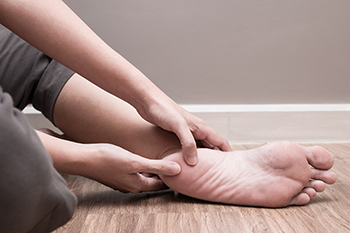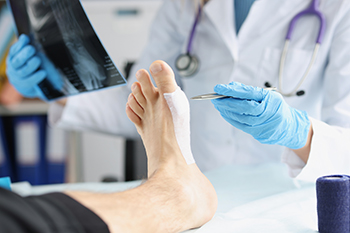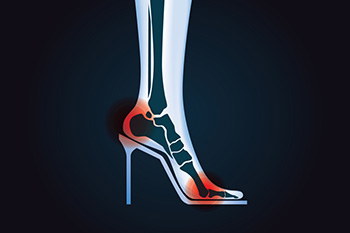Richfield (435) 896-6497
Ephraim (435) 283-4076
June 2024
Common Foot Injuries From Cycling

Cycling, while beneficial for health, can lead to common foot injuries if not approached with care. One frequent issue is known as hot foot, which is a burning sensation caused by nerve compression from wearing tight shoes or from excessive pressure on the pedals. Plantar fasciitis can develop from overuse, resulting in heel pain due to inflammation of the tissue connecting the heel to the toes. Achilles tendonitis, characterized by pain at the back of the ankle, can occur from improper cycling posture or overtraining. Additionally, metatarsalgia, or pain in the ball of the foot, often arises from repetitive stress and wearing poor footwear. Ensuring proper bike fit, wearing well-fitted cycling shoes with adequate support, and gradually increasing training intensity can help prevent these injuries. If you have suffered a foot injury while cycling, it is suggested that you visit a podiatrist who can treat any foot condition, and offer you valuable information that can prevent future foot pain.
Sports related foot and ankle injuries require proper treatment before players can go back to their regular routines. For more information, contact Dr. Blake Zobell of Utah. Our doctor can provide the care you need to keep you pain-free and on your feet.
Sports Related Foot and Ankle Injuries
Foot and ankle injuries are a common occurrence when it comes to athletes of any sport. While many athletes dismiss the initial aches and pains, the truth is that ignoring potential foot and ankle injuries can lead to serious problems. As athletes continue to place pressure and strain the area further, a mild injury can turn into something as serious as a rupture and may lead to a permanent disability. There are many factors that contribute to sports related foot and ankle injuries, which include failure to warm up properly, not providing support or wearing bad footwear. Common injuries and conditions athletes face, including:
- Plantar Fasciitis
- Plantar Fasciosis
- Achilles Tendinitis
- Achilles Tendon Rupture
- Ankle Sprains
Sports related injuries are commonly treated using the RICE method. This includes rest, applying ice to the injured area, compression and elevating the ankle. More serious sprains and injuries may require surgery, which could include arthroscopic and reconstructive surgery. Rehabilitation and therapy may also be required in order to get any recovering athlete to become fully functional again. Any unusual aches and pains an athlete sustains must be evaluated by a licensed, reputable medical professional.
If you have any questions please feel free to contact one of our offices located in Richfield and Ephraim, Utah . We offer the newest diagnostic and treatment technologies for all your foot and ankle needs.
Pain From Heel Fat Pad Atrophy

If you find it difficult to walk or stand for long periods of time due to persistent heel pain, it could be caused by heel fat pad syndrome, also known as fat pad atrophy. This condition results from changes in the elasticity and thickness of the heel fat pad over time, often due to wear and tear on the fatty tissues and muscle fibers. Fat pad atrophy in the heels mimics symptoms of plantar fasciitis but has its own distinct causes and symptoms. Risk factors include overuse, wearing improper footwear, gait imbalances, and certain medical conditions like diabetes or arthritis. Symptoms typically include deep, bruise-like pain in the middle of the heel, increased by weight-bearing activities or walking on hard surfaces. A podiatrist can conduct a thorough evaluation to determine the cause and severity of the condition. Relief options may involve activity modification, custom insoles, and home exercise programs aimed at improving foot biomechanics and muscle control. If you have heel pain, it is suggested that you schedule an appointment with a podiatrist for guidance on correct treatment methods.
Many people suffer from bouts of heel pain. For more information, contact Dr. Blake Zobell of Utah. Our doctor can provide the care you need to keep you pain-free and on your feet.
Causes of Heel Pain
Heel pain is often associated with plantar fasciitis. The plantar fascia is a band of tissues that extends along the bottom of the foot. A rip or tear in this ligament can cause inflammation of the tissue.
Achilles tendonitis is another cause of heel pain. Inflammation of the Achilles tendon will cause pain from fractures and muscle tearing. Lack of flexibility is also another symptom.
Heel spurs are another cause of pain. When the tissues of the plantar fascia undergo a great deal of stress, it can lead to ligament separation from the heel bone, causing heel spurs.
Why Might Heel Pain Occur?
- Wearing ill-fitting shoes
- Wearing non-supportive shoes
- Weight change
- Excessive running
Treatments
Heel pain should be treated as soon as possible for immediate results. Keeping your feet in a stress-free environment will help. If you suffer from Achilles tendonitis or plantar fasciitis, applying ice will reduce the swelling. Stretching before an exercise like running will help the muscles. Using all these tips will help make heel pain a condition of the past.
If you have any questions please contact one of our offices located in Richfield and Ephraim, Utah . We offer the newest diagnostic and treatment technologies for all your foot and ankle needs.
Minor Foot Surgery
 Minor foot surgery encompasses a range of procedures aimed at addressing common foot problems with minimal invasiveness. These surgeries are often performed to correct issues like ingrown toenails, bunions, hammertoes, and plantar warts. Ingrown toenail surgery involves removing part or all of the affected nails to relieve pain and prevent infection. Bunion surgery, or a bunionectomy, involves realigning the bone, ligaments, and tendons to correct the deformity. Hammertoe surgery aims to straighten the bent toe by removing a portion of the bone or releasing the tendon. Plantar wart removal can be performed using various methods, including excision, laser therapy, or cryotherapy. These procedures are typically done on an outpatient basis under local anesthesia, allowing for quick recovery and minimal downtime. If you have any sort of foot problem, it is suggested that you schedule an appointment with a podiatrist. After a thorough examination and imaging tests, the best treatment, which may include minor surgery, will be discussed.
Minor foot surgery encompasses a range of procedures aimed at addressing common foot problems with minimal invasiveness. These surgeries are often performed to correct issues like ingrown toenails, bunions, hammertoes, and plantar warts. Ingrown toenail surgery involves removing part or all of the affected nails to relieve pain and prevent infection. Bunion surgery, or a bunionectomy, involves realigning the bone, ligaments, and tendons to correct the deformity. Hammertoe surgery aims to straighten the bent toe by removing a portion of the bone or releasing the tendon. Plantar wart removal can be performed using various methods, including excision, laser therapy, or cryotherapy. These procedures are typically done on an outpatient basis under local anesthesia, allowing for quick recovery and minimal downtime. If you have any sort of foot problem, it is suggested that you schedule an appointment with a podiatrist. After a thorough examination and imaging tests, the best treatment, which may include minor surgery, will be discussed.
Foot surgery is sometimes necessary to treat a foot ailment. To learn more, contact Dr. Blake Zobell of Utah. Our doctor will assist you with all of your foot and ankle needs.
When Is Surgery Necessary?
Foot and ankle surgery is generally reserved for cases in which less invasive, conservative procedures have failed to alleviate the problem. Some of the cases in which surgery may be necessary include:
- Removing foot deformities like bunions and bone spurs
- Severe arthritis that has caused bone issues
- Cosmetic reconstruction
What Types of Surgery Are There?
The type of surgery you receive will depend on the nature of the problem you have. Some of the possible surgeries include:
- Bunionectomy for painful bunions
- Surgical fusion for realignment of bones
- Neuropathy decompression surgery to treat nerve damage
Benefits of Surgery
Although surgery is usually a last resort, it can provide more complete pain relief compared to non-surgical methods and may allow you to finally resume full activity.
Surgical techniques have also become increasingly sophisticated. Techniques like endoscopic surgery allow for smaller incisions and faster recovery times.
If you have any questions please feel free to contact one of our offices located in Richfield and Ephraim, Utah . We offer the newest diagnostic and treatment technologies for all your foot and ankle needs.
Are You Suffering From Ingrown Toenails?
The Perils of Fashion May Include Wearing High Heels

Fashion trends often dictate footwear choices, but some styles can take a toll on foot health, particularly for women. High heels, revered for their elegance and sophistication, are notorious culprits in causing a myriad of foot problems. The elevated heel places excessive pressure on the forefoot, leading to issues like bunions, hammertoes, and neuromas. Moreover, prolonged wear of high heels can shorten the Achilles tendon, contributing to calf tightness and discomfort. The narrow toe box squeezes toes together, increasing the risk of ingrown toenails and corns. Additionally, high heels alter the body's natural alignment, leading to lower back pain and postural imbalances. Despite their allure, high heels can wreak havoc on foot anatomy and function. Opting for footwear with lower heels and adequate arch support can help reduce these risks while still maintaining style. Wearing high heels may cause foot pain, and there are a variety of foot conditions that can develop. If this applies to you, it is suggested that you schedule an appointment with a podiatrist who can treat foot ailments from high heel use.
High heels have a history of causing foot and ankle problems. If you have any concerns about your feet or ankles, contact Dr. Blake Zobell from Utah. Our doctor can provide the care you need to keep you pain-free and on your feet.
Effects of High Heels on the Feet
High heels are popular shoes among women because of their many styles and societal appeal. Despite this, high heels can still cause many health problems if worn too frequently.
Which Parts of My Body Will Be Affected by High Heels?
- Ankle Joints
- Achilles Tendon – May shorten and stiffen with prolonged wear
- Balls of the Feet
- Knees – Heels cause the knees to bend constantly, creating stress on them
- Back – They decrease the spine’s ability to absorb shock, which may lead to back pain. The vertebrae of the lower back may compress.
What Kinds of Foot Problems Can Develop from Wearing High Heels?
- Corns
- Calluses
- Hammertoe
- Bunions
- Morton’s Neuroma
- Plantar Fasciitis
How Can I Still Wear High Heels and Maintain Foot Health?
If you want to wear high heeled shoes, make sure that you are not wearing them every day, as this will help prevent long term physical problems. Try wearing thicker heels as opposed to stilettos to distribute weight more evenly across the feet. Always make sure you are wearing the proper shoes for the right occasion, such as sneakers for exercising. If you walk to work, try carrying your heels with you and changing into them once you arrive at work. Adding inserts to your heels can help cushion your feet and absorb shock. Full foot inserts or metatarsal pads are available.
If you have any questions please feel free to contact one of our offices located in Richfield and Ephraim, Utah . We offer the newest diagnostic and treatment technologies for all your foot and ankle needs.









